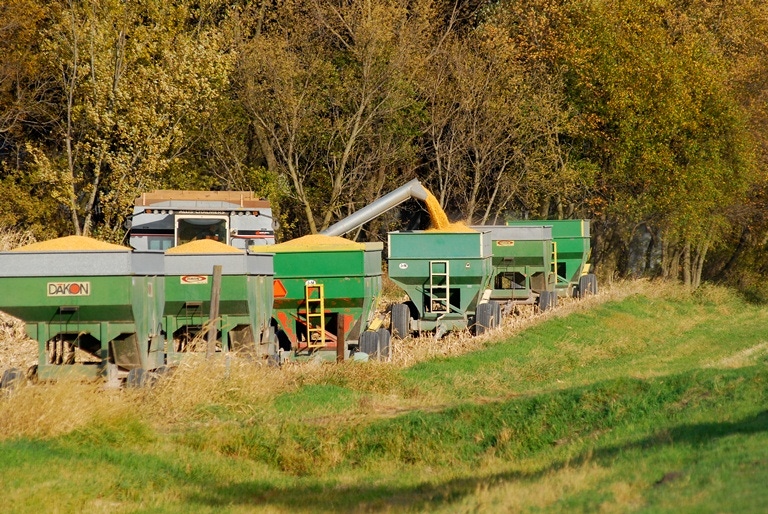November 18, 2013

If fed to hogs, corn is worth an estimated $6.85 per bushel when the profits from hog production are assigned to the value of corn, says Chris Hurt, Purdue University Extension economist. That’s good to know for grain farmers who are seeking new ways to add value to corn.
Hurt explains that livestock was historically the way to add value to abundant corn supplies on Midwest farms. During the first-half of the 1800s, what is now the eastern Corn Belt became the center of hog production. Cincinnati was nicknamed “Porkopolis” in 1835. By the end of the Civil War in 1865, public monies were being used to open terminal markets farther west with the Chicago Union Stockyards the most famous. The center of the hog industry has continued to move farther west to Missouri, Iowa, Minnesota and Nebraska in the past 50 years.
“Today most corn growers cannot add hogs to their farm enterprises,” Hurt says. “Modern hog production is large-scale, high-tech, high-investment and highly coordinated. So the hope for most corn growers is that large hog production corporations will expand rapidly and thereby expand the corn usage base.”
How big is the incentive for hog expansion?
“At first glance, it appears to be very large,” Hurt says. “During the period that spans the 2013-14 corn marketing year, live hog prices are expected to average about $67 per hundredweight with costs of production closer to $56. That means an expected profit of $32 per head and relates to the $6.85 per bushel for corn marketed through hogs. Unfortunately, it takes time to get into hog production, and gilts retained now will not have market-ready pigs until late 2014 when much of the profit incentive will be eroded. That profit erosion is due to the expected expansion already underway and to somewhat higher corn prices for the 2014-15 marketing year,” he says.
According to Hurt, the best news for the hog industry and other animal industries is that feed prices will probably moderate for a series of years, not just this one year. “If so, that means an extended period of lower feed prices and expansion of animal production,” Hurt says. “Over the next three to five years, expect a ‘mini-boomlet’ for animal industries in which three positive demand drivers will occur: higher U.S. per capita consumption, modest domestic population growth and continued growth of exports,” he says.
For hog production in the coming year, Hurt says that this means a 1-3% expansion of the breeding herd that has already begun. Increased pork production from this expansion will begin by late summer of 2014, and prices will move below year-previous levels at that time. As an example, hog prices in the last quarter of 2014 are expected to be $58 per live hundredweight compared with $65 during the last quarter this year.
Hurt says that the big profits will come during the 2013-14 corn marketing year, reaching $37 per head of profits on average during the second and third quarters of 2014.
Hog prices are expected to average around $65 in late 2013 and the first quarter of 2014. Then record-high hog prices are anticipated in the second quarter with an average near $72, followed by $67 for the third quarter. As pork supplies begin to rise into the fall of 2014, hog prices are expected to drop $9 per live hundredweight to around $58.
“While hog prices are strong, it is really lower feed costs that are providing the strong profitability forecasts,” Hurt says. “In the peak of the 2012 drought, hog production costs were near $73 in the third quarter of 2012. Those have dropped to about $56 for the coming year.
“While selling corn at $6.85 per bushel is appealing to cash grain farmers, it is important for them to recognize that the high feed prices resulting from the 2012 drought caused large losses,” Hurt continues. “In the current profitable period, it will take until June 2014 to recover the losses that were suffered from drought-induced high feed costs. After many years of often high and very volatile feed prices, the future appears brighter for all of the animal species with feed prices moderating over the coming years. With moderation should also come less volatility. The pork industry is well positioned to take advantage of several years of favorable consumer expansion driven by improving domestic consumption and foreign demand,” Hurt says.
Hurt concludes that the hog industry expansion will not be large enough to return corn prices to the previous lofty levels. However, when all animal industries are included, it will be a period of growing feed-use base for corn growers. Thus, it is anticipated that in coming years there will be a better balance between the crop production sector and the animal sector.
“Assuming ethanol use is relatively level in the future, this means that corn farmers have achieved the goal of providing sufficient production for both food and fuel,” Hurt says.
You May Also Like



